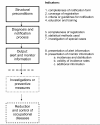Characteristics of national registries for occupational diseases: international development and validation of an audit tool (ODIT)
- PMID: 19852775
- PMCID: PMC2773237
- DOI: 10.1186/1472-6963-9-194
Characteristics of national registries for occupational diseases: international development and validation of an audit tool (ODIT)
Abstract
Background: The aim of the study was to develop quality indicators that can be used for quality assessment of registries of occupational diseases in relation to preventive policy on a national level. The research questions were: 1. Which indicators determine the quality of national registries of occupational diseases with respect to their ability to provide appropriate information for preventive policy? 2. What are the criteria that can distinguish low quality from high quality?
Methods: First, we performed a literature search to assess which output of registries can be considered appropriate for preventive policy and to develop a set of preliminary indicators and criteria. Second, final indicators and criteria were assessed and their content validity was tested in a Delphi study, for which experts from the 25 EU Member States were invited.
Results: The literature search revealed two different types of information output to be appropriate for preventive policy: monitor and alert information. For the evaluation of the quality of the monitor and alert function we developed ten indicators and criteria. Sixteen of the twenty-five experts responded in the first round of the Delphi study, and eleven in the second round. Based on their comments, we assessed the final nine indicators: the completeness of the notification form, coverage of registration, guidelines or criteria for notification, education and training of reporting physicians, completeness of registration, statistical methods used, investigation of special cases, presentation of monitor information, and presentation of alert information. Except for the indicator "coverage of registration" for the alert function, all the indicators met the preset requirements of content validity.
Conclusion: We have developed quality indicators and criteria to evaluate registries for occupational diseases on the ability to provide appropriate information for preventive policy on a national level. Together, these indicators form a tool which can be used for quality improvement of registries of occupational diseases.
Figures
Similar articles
-
Evaluation of occupational disease surveillance in six EU countries.Occup Med (Lond). 2010 Oct;60(7):509-16. doi: 10.1093/occmed/kqq133. Occup Med (Lond). 2010. PMID: 20871020
-
A systematic approach towards the development of a set of quality indicators for public reporting in community-based maternity care.Midwifery. 2013 Apr;29(4):316-24. doi: 10.1016/j.midw.2012.01.012. Epub 2013 Jan 26. Midwifery. 2013. PMID: 23357096
-
Development of a core set of quality indicators for paediatric primary care practices in Europe, COSI-PPC-EU.Eur J Pediatr. 2018 Jun;177(6):921-933. doi: 10.1007/s00431-018-3140-z. Epub 2018 Apr 14. Eur J Pediatr. 2018. PMID: 29654400
-
Development of an evaluation indicator system for the rational use of proton pump inhibitors in pediatric intensive care units: An application of Delphi method.Medicine (Baltimore). 2021 Jun 18;100(24):e26327. doi: 10.1097/MD.0000000000026327. Medicine (Baltimore). 2021. PMID: 34128875 Free PMC article. Review.
-
National registries of rare diseases in Europe: an overview of the current situation and experiences.Public Health Genomics. 2015;18(1):20-5. doi: 10.1159/000365897. Epub 2014 Sep 9. Public Health Genomics. 2015. PMID: 25228300
Cited by
-
A hospital occupational diseases unit: an experience to increase the recognition of occupational disease.Med Lav. 2019 Aug 26;110(4):278-284. doi: 10.23749/mdl.v110i4.8138. Med Lav. 2019. PMID: 31475689 Free PMC article.
-
Prevention of Occupational Diseases in Turkey: Deriving Lessons From Journey of Surveillance.Saf Health Work. 2019 Dec;10(4):420-427. doi: 10.1016/j.shaw.2019.09.006. Epub 2019 Sep 27. Saf Health Work. 2019. PMID: 31890324 Free PMC article.
-
Reducing the underreporting of lung cancer attributable to occupation: outcomes from a hospital-based systematic search in Northern Italy.Int Arch Occup Environ Health. 2016 Aug;89(6):981-9. doi: 10.1007/s00420-016-1135-5. Epub 2016 Apr 30. Int Arch Occup Environ Health. 2016. PMID: 27137812
-
Understanding occupational safety and health surveillance: expert consensus on components, attributes and example measures for an evaluation framework.BMC Public Health. 2022 Mar 14;22(1):498. doi: 10.1186/s12889-022-12895-6. BMC Public Health. 2022. PMID: 35287647 Free PMC article. Review.
References
-
- Fingerhut M, Driscoll T, Nelson DI, Concha-Barrientos M, Punnett L, Pruss-Ustin A, Steenland K, Leigh J, Corvalan C. Contribution of occupational risks factors to the global burden of disease - a summary of findings. Scandinavian Journal of Work and Environmental Health Supplements. 2005;1:58–61.
-
- Leigh JP, Waehrer G, Miller TD, Keenan C. Cost of occupational injuries and illness across industries. Scand J Work Environ Health. 2004;30:199–205. - PubMed
Publication types
MeSH terms
LinkOut - more resources
Full Text Sources
Medical
Miscellaneous


